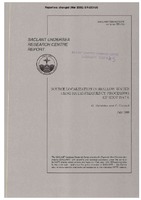| dc.contributor.author | Haralabus, Georgios | |
| dc.contributor.author | Gerstoft, P. | |
| dc.date.accessioned | 2018-10-11T14:07:52Z | |
| dc.date.available | 2018-10-11T14:07:52Z | |
| dc.date.issued | 1996/07 | |
| dc.identifier | 10657 | |
| dc.identifier.govdoc | SR-253 | |
| dc.identifier.uri | http://hdl.handle.net/20.500.12489/369 | |
| dc.description.abstract | Multi-frequency processing methods are applied to real data generated by explosives to examine the | |
| dc.description.abstract | variability of geometric and environmental parameter estimates. The frequencies are combined in an | |
| dc.description.abstract | incoherent fashion and genetic algorithms are employed in an efficient global search scheme The | |
| dc.description.abstract | source coordinates, the water depth at the source and the receiver location, and the tilt of the vertical array are estimated as functions of the number of frequencies processed. Using three different processing schemes. it is found that when less than ten frequencies are employed the estimates are unstable, whereas after this critical number a constant estimation level is attained. The localization performance of a multi-frequency version of the Bartlett processor is also examined. The degradation of the results due to a non-optimized environment is demonstrated. The source resolution is shown to be improved when the search for the source coordinates incorporates simultaneous estimation of the environmental parameters. | |
| dc.format | vi, 24 p. : ill. ; 10 fig. | |
| dc.language | English | |
| dc.publisher | NATO. SACLANTCEN | |
| dc.relation.ispartofseries | ADA318792 | |
| dc.subject | Shallow water | |
| dc.subject | Target localization | |
| dc.subject | Sonar | |
| dc.subject | Signal processing | |
| dc.subject | Geoacoustic inversion | |
| dc.title | Source localization in shallow water using multi-frequency processing of shot data | |
| dc.type | Scientific Report (SR) | |
